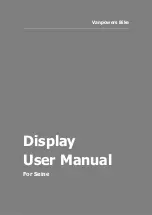
Continuing from Step 3 above, note the deviation of your target from the central
cross hair. To align your reticule you need to
move
it so that 1/2 of the error is
corrected.
Locate the three small Allen screws around the perimeter of the
Polar Scope
eyepiece. You are going to tighten/loosen each one so that the cross hair in the
reticule is positioned 1/2 way to the target in its deviated position.
Choose one of the screws and loosen it 1/4 turn. Note the movement of the
cross hair. If it
moves
in the correct direction, tighten the two other screws
about 1/4 turn each, then loosen the original screw again.
With each loosening/tightening of the opposing screws the cross hair will
move.
Continue until it is positioned at a point that is half way out to the target at its
maximum deviated position. Now, gently tighten all three adjustment screws.
Adjust the tilt/pan head, ball head or equatorial wedge to place your target
back under the cross hair. Now, rotate SAM 180 degrees in the opposite
direction and note the location of your target relative to the cross hair.
If the target has displaced again, repeat steps 4 through 6. Perfrom the
adjustments until the target no longer
moves
from beneath the cross hair
when SAM is rotated through 180 degrees.
Remember:
38
First verify that your
Polar Scope
requires calibration before starting the
calibration adjustments! When adjusting the Allen screws, always proceed by
loosening one screw then tightening the other two gently.
Do not loosen one screw completely or loosen more than one screw at a time
as the reticule may lose its support and become nonadjustable.
To make things easier, perform the calibration during the daytime.
The three reticule adjustment
screws are equally spaced around
the perimeter of the polar scope
near the eyepiece. (NOTE: Two of
the screws are hidden from view
in this photo.)
CAUTION: DO NOT over tighten
the screws as you may crack the
glass reticule inside the eyepiece
of the polar scope.
Level
Mounting Plate
Stopper
Altitude
Scale
Adjustment
Knob
Appendix Ill: The Optional Equatorial Wedge
If you plan to do a lot
of
astrophotography with SAM then you should
seriously consider purchasing the
Equatorial Wedge
(wedge). This
accessory makes the fine pointing control that is necessary for polar
alignment procedures much more easily accomplished than using a
standard tilt/pan head or ball mount.
The
Equatorial Wedge
includes the following key parts:
Mounting Plate:
The
Mounting Plate
includes a 1/4 inch threaded bolt for
attaching a camera or standard camera accessory, such as a ball mount.
Stopper:
The
Stopper
acts as a safeguard against your camera payload
slipping out of the
Saddle
of the
Equatorial Wedge
should you let go of it
before tightening the
Mounting Plate Locking Knob.
Azimuth {Horizontal) Adjustment Knob:
This knob enables fine pointing
of the wedge in the right and left directions (azimuth directions). It is
especially useful when making fine adjustments for the
Easy
and
Advanced
Polar Alignment Procedures.
Altitude {Vertical) Adjustment Knob:
This knob enables fine pointing of
the wedge in the up and down (altitude) directions. It is especially useful
when making fine adjustments for the
Easy
and
Advanced Polar Alignment
Procedures.
Altitude Scale:
This scale indicates the altitude setting of the wedge. Note
that for polar alignment procedures, the altitude of your wedge is equal to
the latitude of your observing site if your wedge and tripod are setto level.
Bubble Level:
A built-in level to assist you in setting your tripod and
wedge to level. Note that a perfectly level tripod is not a requirement
for using SAM in equatorial mode, but it does make the polar alignment
adjustments a bit easier.
Altitude Lock Handle:
Loosen this handle slightly before making latitude
adjustments, then re-tighten when finished.
39




































